 |
|
|
 |
2004
August
29
|
Fabulous fifties phono
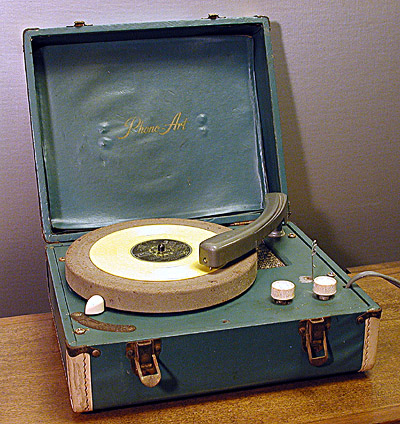
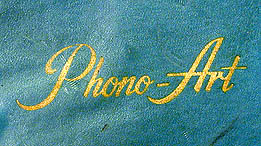
You can find anything on eBay, and I did.
Specifically, I found a record player just like the one that served
me so well from about 1959 to 1964, i.e., ages 2 to 7.
This is an ideal addition to my vintage electronics collection... so here it is.
One of my earliest memories is of the trip to Grant's (a variety store in the building that
is now Southern Stationery, in Valdosta, Georgia) to buy a record player.
I was intrigued by the calligraphic words "Phono-Art" inside the lid.
(Yes, I could read when I was 2 years old - but I was often puzzled by
unusual typefaces.)
I went home and played records... and played records... and played records...
(I wish I could say this early memory could definitely be dated to 1959, because if so,
it would be the only event I remember that took place in the Fifties.
But it might actually have been as late as the spring of 1960.
After June, 1960, we had moved to a different town and wouldn't have bought it at Grant's.)
Although usable by children, this was certainly not a super-cheap "kiddie phono" in its time.
It has a fine German-made motor and a tone control as well as a volume control.
As late as the mid-1960s, the cheapest "kiddie phonos" were purely acoustic,
like a Victrola, with no electronic amplification.
I remember a friend who had one; it didn't sound very good.
Amazingly, this relic, when I received it, was electronically perfect; there wasn't even
any hum.
(I had been looking forward to an interesting restoration job... No. It works already.)
It needed a mechanical repair to make the turntable work, and now it's fully
functional.
But this seems to be an earlier variety of this model than the one I actually had.
Mine had a flip-over cartridge for playing 78s and LPs, while this one has a more primitive
cartridge with a steel (!) needle.
I've located a tone arm very like the one that was on mine, and I'm going to make the change.
At the same time, I'll map out the circuit, which I haven't done yet,
and attach a power cord that looks authentic but has correct polarization for use in modern times.
The amplifier has one tube (117L7M7GT ?) and a selenium rectifier.
This is obviously not the earliest version of the circuit, because the selenium
rectifier sits right under a hole that could have held a tube socket.
Actually, the first electronic repair I ever saw anyone do was the replacement of the tone
arm on my record player.
(Watching it started me down a long path...)
The new tone arm that I've located will match the replacement one (circa 1962) and will be
safe to play records on. (I don't trust that steel needle.)
But even my original tone arm was more modern than the one you see in the picture.
This must be the early-1950s version.
Does anyone other than me care about any of this?
Perhaps not... but there is an amazing number of vintage electronics collectors and restorers
on the Internet.
Maybe some Phono-Art fancier will see this and write to me.

|
 |
2004
August
28
|
The Boys' Second Book of Radio and Electronics
Now for the long-promised tribute to
the
best of Alfred Morgan's books.
This tome was one of my favorites when I was 12 years old (around 1969).
I never actually built any of the projects in it, but I learned a lot.
The book explains a great deal of electronics - especially radio - from
the ground up, as well as presenting an interesting set of build-it-yourself projects,
such as audio amplifiers, a Geiger counter, and a phototube-controlled relay.
As a designer, Morgan was genuinely creative.
His circuits are conservatively designed and look reliable, but at the same time,
he does innovative things, such as generating the high voltage for the Geiger tube
by stepping up DC pulses with an audio output transformer (wired backward)
and rectifying them with a spark gap (possible because the positive pulses are
stronger than the negative ones).
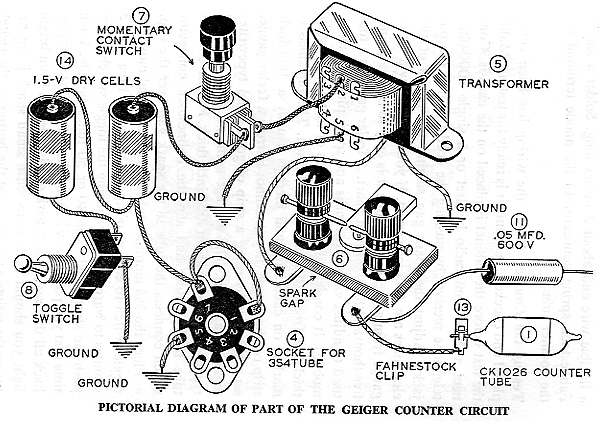
The biggest thing I got from Morgan was a set of construction techniques that
don't involve metalworking.
All the projects in magazines at the times were built on metal chassis
and required lots of special tools (drills, nibblers, and punches) to get
the chassis ready.
(I'm talking about the vacuum-tube era; and in those days, even transistor
equipment was built that way.)
Morgan revived the pre-WWII "breadboard" construction style, where you
mounted everything on spacers on a flat piece of wood.
This made it possible to deal with tube sockets without punching a 1.5-inch hole
in a piece of steel.
That made construction cheaper and safer for young experimenters.

The circuits still violated some modern safety procedures - in particular,
most had exposed high-voltage wiring - but at least there wasn't a metal
chassis that could get electrified.
I still build things on wooden panels
(for example the prototype of the world-famous, I mean infamous,
"No-Parts PIC Programmer").
It's an elegant way to display one's handiwork.
The key idea behind it is that prototypes don't have to look like manufactured products.
They just have to do their own thing well, in their own way.
Once you admit that, electronics becomes a lot easier.
Morgan's prose style now strikes me as stilted. For example:
Let's see what happens when a capacitor is connected to a direct current voltage source,
as, for example, to the terminals of a battery.
Since the dielectric between the plates is a non-conductor, a capacitor might
be expected to behave as a break in the circuit.
When connected to a source of steady direct current, it does act as
an open circuit except for a very short time while it is charging.
I would probably have written:
Let's see what happens when a capacitor is connected to a DC voltage source,
such as a battery.
Since the dielectric between the plates does not conduct electricity,
you might expect no current to flow at all.
And, indeed, no current flows, except for a small amount for a short
time while the capacitor is charging.
Which one is easier for a young reader to understand?
I don't know!
My style is more cohesive (to use the technical term);
that is, there are more words that depend
directly on something in a preceding sentence.
That makes my sentences and phrases a little simpler, but it also requires
the reader to remember what has come before.
Maybe Morgan's repetition has some advantages for a slow reader.
Morgan's real strength is that he gives you all the information needed to understand
what he's saying.
All too many expository writers don't make points; they just dance around them,
in the hope that you'll guess what they have in mind.
 Another trip to Fry's, this time with Sharon in tow,
for the second day of the one-day sale
(all I know is what I read in the papers!).
We came back with several gadgets, including a 175-watt inverter ($18, with 100% rebate)
for charging the laptops in the car.
Another trip to Fry's, this time with Sharon in tow,
for the second day of the one-day sale
(all I know is what I read in the papers!).
We came back with several gadgets, including a 175-watt inverter ($18, with 100% rebate)
for charging the laptops in the car.
So I've been to Fry's on three consecutive days, and got in on two of them.
Now I promise I'll stay away at least a week!

|
 |
2004
August
27
|
Successful Fry-day / Making Windows search all types of files
 This evening Melody and I went to Fry's again, and this time we got in.
This evening Melody and I went to Fry's again, and this time we got in.
This isn't quite like the Sunnyvale or Los Angeles Fry's. Grafted onto the nerd's paradise is a large store
selling consumer electronics - everything from car audio to washing machines. It's enormous, the size of
a large Home Depot. The decor theme for Atlanta
is simply "elegant department store" with lots of marble and gilt lettering.
The really specialized items are, I think, a bit less in evidence than in Sunnyvale or Los Angeles - but
it's been a while since I've been there, so this may be a Fry's-wide trend.
The selection of merchandise consists of popular, big-selling items with a few top-end items mixed in.
For instance, the camera section has a few Zeiss binoculars alongside the cheap off-brands;
the telescope section has a
Celestron 11 and
NexStar 9 1/4 GPS alongside entry-level products.
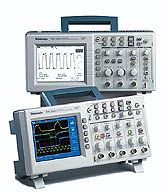 The electronic test equipment comprises many staple items and also some
Tektronix digital oscilloscopes
(up to $4700 or so). (I learned that the TDS 102 that I use is passé; it doesn't do
Fourier transforms.)
The electronic test equipment comprises many staple items and also some
Tektronix digital oscilloscopes
(up to $4700 or so). (I learned that the TDS 102 that I use is passé; it doesn't do
Fourier transforms.)
The components comprise a lot of NTE
resistors, capacitors, relays, and replacement
semiconductors, together with Surfboards
for surface-mount prototyping, lots of breadboarding and
protoyping products, enclosures, soldering tools... Just the kind of thing an independent consultant
or experimenter might need to finish or repair a product, assuming the really specialized parts had
already been obtained from elsewhere.
Much better than Radio Shack, and it's open in the evenings;
for a wider selection, go down the road to
RS Electronics during the business day.
As a loss leader, they were selling Joli Ballew and Jeff Duntemann's
Degunking Windows
with a 100% rebate.
Useful book!
It's just what it sounds like - a book about how to clean up the pesky problems
that seem to accumulate on your PC. I got the last copy.
You should order one from Amazon or your favorite bookstore.

Curiously, when you use the "Search" feature in Windows
to look for files containing specific words or phrases,
Windows does not search all types of files - only those it thinks it knows how to read as text.
Our graduate student Julian Bishop was bitten by this, and we found the fix.
Download and run this registry script, or simply open it
with a text editor to find out what to set.
Note that it does not require Indexing Service to be turned on, nor does it affect whether it's turned on.
I recommend keeping Indexing Service turned off unless you do a lot of searches.

|
 |
2004
August
26
|
Do you want Fry's with that?
Today was a great day for Atlanta - or should have been.
It marks the opening of the first
Fry's Electronics
store in the Southeast.
For those of you who don't know, a Fry's store is a Wal-Mart-sized emporium of
computers, computer accessories, electronic parts, and test equipment.
The last time I was in one was in Los Angeles around 1996, and it was amusing
to see Tektronix oscilloscopes displayed on a faux Hawaiian table with
lots of grass and bamboo. (Strange decor is a hallmark of Fry's.)
When I got word that the Atlanta store was open, I called it and was assured
that it would be open until 9 p.m.
So Melody, Cathy, Sharon, and I set out for Gwinnett County
(50 miles away).
We ate dinner at Chili's there, then went to Fry's.
Or tried to.
Alas, 'twas not to be.
They were closed.
The place was buzzing with activity, but they wouldn't let me in.
So we went to a competing store, ran a few other errands, and came back home.
I then tried to report the problem on Fry's online complaint form,
but it, too, wasn't working.
We may try again tomorrow or the next day. I plan to call the store manager first
and double-check the operating hours.
Alfred Morgan may make it into tomorrow's blog entry.
Or maybe there will be a review of Fry's.

|
 |
2004
August
25
|
Small progress on the Windows DNS mystery
I still haven't figured out why my PCs are occasionally getting incorrectly DHCP-served
with DNS addresses (see 2 days ago), but I've established that the erroneous information
comes in via DHCPINFORM packets, not at renewal of the DHCP lease.
I think the campus DHCP server is misbehaving.
But I want to thank Sharad Naik,
on the newsgroup
microsoft.public.windows.server.dns,
for a
useful piece of information.
I knew already that, beginning with Windows XP, there is a
Group Policy for specifying DNS servers
throughout a domain.
You get to it from Active Directory Users and Computers; right-click on the domain name, choose Properties,
Group Policy, Default Domain Policy, Edit.
It overrides both local and DHCP (automatic) settings.
What puzzled me is that it never seemed to have any effect; ipconfig still showed the same DNS
servers as before (sometimes the wrong set of them, sometimes the right set).
Well, what Sharad revealed is that ipconfig doesn't always tell the truth.
When the Group Policy has set the DNS servers, ipconfig will still show them as if it hadn't.
But if you actually execute a command such as
nslookup blah.blah.blah
(where blah.blah.blah is of course nonexistent), you'll find you're using the server specified
in Group Policy, despite what ipconfig says.
Accordingly, I can use the Group Policy to ensure that the whole domain has the right servers,
regardless of what the DHCP server tries to do to us!
I'll write more about Alfred Morgan's Boys' Second Book of Radio and Electronics tomorrow,
and maybe in subsequent days I may even get to Hugo Gernsback.

|
 |
2004
August
24
|
Bibliophile's triumph
Through a used book search on
Amazon,
I've succeeded in buying, for about $7, a well-preserved copy of
The Boys' Second Book of Radio and Electronics,
by Alfred Morgan,
which was one of my favorites at the Valdosta Public Library around 1969.
I'll write about its contents tomorrow.
In the meantime let me just point out that it's a book with a cult following;
one just like mine is going for over $75
on
eBay right now,
and there are book dealers asking more than $1000 per copy
on Alibris
(presumably for early printings; mine is the tenth, which seems to have been the most popular).
I consider Amazon Marketplace more reliable than the web sites that just link book dealers together,
because the Amazon seller has an obligation to fill the order.
All too often, independent book dealers mysteriously don't have the item if it's a real bargain.
You can easily sell your own books through Amazon; I've sold a couple of dozen unwanted tomes there myself.
People are directed to you whenever they search for the specific book you're selling.
All you have to tell Amazon is the ISBN, condition, and asking prices.

|
 |
2004
August
23
|
Busy day
Too busy to write much here today...
but I'm selling a few items on
eBay (some of them quite odd)
and have written an article for
Astromart.
And there are always amusing things to read on
News of the Weird.

|
 |
2004
August
22
|
Progress on mystery / Son of "Bubba oscillator"
A faint glimmer of progress on yesterday's Windows mystery...
There's a kind of DHCP packet called DHCPINFORM that can change the settings for DNS servers, etc.,
without establishing a new "lease" (redoing the whole process of DHCP-serving a computer).
And my computer appears to have gotten a DHCPINFORM from the campus DHCP server just before it
mysteriously changed DNS servers.
My guess? The server is giving out the wrong data (the campus defaults, rather than the settings
that are specific for me) when it does a DHCPINFORM.
More news as it unfolds...
A few more notes about the "Bubba oscillator" that I was writing
about on August 18...
The book in which I found the circuit is
Op Amps for Everyone,
edited by Ron Mancini of Texas Instruments.
The descriptions of it on pp. 255-257 and A-43 are muddled as regards biasing.
The schematic on p. 256 correctly shows the first op-amp biased halfway between V+ and V- (i.e.,
in this case, +2.5V).
The text and the latter schematic say that you should only bias to 0.5 of the way from V- to V+
because of the dc gain of the amplifier.
And that's wrong. That's just not how biasing works.
Several of the other oscillators in Appendix A have equally implausible recommendations about biasing.
When I breadboarded this circuit on August 18, I failed to note a couple of things.
First, the TL084 requires a rather wide span between V+ and V-.
The single-supply version needs at least a 12-volt and preferably a 20-volt supply.
The distortion is considerably less when the supply voltage is adequate.
Second, the phase shift is 45 degrees between stages, not 90. (Of course.)
To get a circular oscilloscope trace, I used sine waves from the second and fourth
output. Both were relatively undistorted when I used a high enough supply voltage
(though the output of stage 1 is always clipped; that's what sets the oscillator amplitude).
 Now here's "Son of Bubba."
If all you want is one sine wave, you can get it with 2 fewer parts than Bubba used.
Although I thought it up independently, a circuit like this is suggested on p. 254 of the book.
Note that the first stage feedback resistor has been changed and that the
operating frequency is higher (about 270 Hz).
Now here's "Son of Bubba."
If all you want is one sine wave, you can get it with 2 fewer parts than Bubba used.
Although I thought it up independently, a circuit like this is suggested on p. 254 of the book.
Note that the first stage feedback resistor has been changed and that the
operating frequency is higher (about 270 Hz).
I'm not sure whether this is really any better than just using two op-amps, one as
a phase shift oscillator and the other as a buffer.

|
 |
2004
August
21
|
Windows DNS mystery
A domain name system server (DNS server) is a computer that tells another computer the
meaning of a domain name.
For instance, if you want to look at www.ai.uga.edu, somebody has to tell
your computer that it's 128.192.12.3 so your network can find a route to it.
That's the job of a DNS server.
To find out what DNS servers you're using, go to a command prompt and type:
ipconfig /all
There are usually two, three, or even four of them.
What tells your PC what DNS servers to use?
As far as I know, three things:
- They can be set in the Properties of TCP/IP, under Control Panel, Network Connections.
By default, this is not done, and you fall back on the other 2 methods.
- They can be supplied by DHCP (the protocol that allows another computer to give your computer
a lot of information about its network connection).
Most of us who have high-speed lines at home are DHCP-served by our broadband routers or cable modems.
- Beginning with Windows Server 2003, there's also a Group Policy that hands out a list of DNS servers
to all the computers to which it applies.
Now for the mystery. Bear with me for a moment, and if you can solve it, please e-mail me!
At the office, we have two DNS servers in our own domain (call them A and B), and the University has
three campus-wide ones (call them X, Y, and Z).
Just as in any Active Directory domain, each
of our networked PCs needs to use A and B for its DNS servers, to get full functionality.
Otherwise it's unable to do a few things on the local area network.
Now here's the strange part.
After being correctly DHCP-served with A and B, our PCs spontaneously change over to using X, Y, and Z
some time during the day.
The people who run the campus DHCP server insist that they aren't serving out the wrong DNS addresses.
Indeed, the DHCP "lease" isn't renewed at the time of the changeover.
Instead, if you renew it (by doing an ipconfig /renew),
it becomes correct again.
So are we getting the wrong addresses from Group Policy?
Not as far as I can determine: gpupdate does not make them go wrong,
and rsop.msc shows no Group Policies coming from anywhere unexpected.
When the problem appeared, the Group Policy for DNS servers was not set anywhere in our domain.
I set it (to B, A, and X, in that order - to make it distinguishable from the campus DHCP server, which
tells our machines to use just A and B)
and have never seen it take effect, even though all our other
Group Policies (what few we use) work as advertised.
We have determined that if we set the DNS server list in Properties of TCP/IP
(which has to be done individually on each machine), it stays correct all the time.
Right now I've left this undone on one machine, so I can monitor the problem, and I've set up a script
to do ipconfig /all every 5 minutes and write the result to a file, along with
the date and time. When a mysterious changeover happens, I'll check my logs for the 5-minute period in which
it took place. But so far, none have been observed.
This in itself raises some questions.
Does the problem occur because of something that someone runs during the daytime on workdays, not over weekends?
It isn't an effect of Service Pack 2. We've seen it on machines that are running SP2 and machines that aren't.
"Inquiring minds want to know..."

|
 |
2004
August
19-20
|
Welcome to CSCI 4540 / Reinventing eBay
 Welcome to Computer Science 4540.
This is where it meets!
Welcome to Computer Science 4540.
This is where it meets!
Apparently one of the University's construction projects is a little off schedule.
Believe it or not, the interior of the building is perfectly serviceable
(except for a couple of dead air conditioners); you just have to find the
back entrance.
Has sniping ruined eBay?
And is there a better way to do online auctions?
I've just been arguing yes and yes, in a lengthy
discussion on
sci.electronics.components.
Sniping is the practice of submitting a high bid just a second or two before an auction closes.
It is now done automatically by software; that is, there are servers that will monitor an auction for you
and submit your bid at the last instant.
And the trouble with sniping is that it makes the open bids worthless.
You can't watch the bidding taking place.
But it looks like you can - you can see any non-snipe bids that people happen to be placing - and that's misleading.
The other trouble with sniping is that it's unreliable.
Nobody can guarantee that there won't be a 1- or 2-second network delay that keeps your bid from arriving.
Recall that eBay isn't quite like a regular auction.
In a traditional auction, the highest bidder pays the price he has bid, and the auctioneer always
invites people to bid higher yet.
There is no fixed closing time; the auction continues if bids are still rising.
On eBay, the system is based on proxy bidding, which I like.
If you bid $25, you are actually authorizing eBay's computer to bid up to $25 for you,
starting at the lowest possible increment above the next highest bid.
So the highest bidder wins, but the selling price is just one increment (maybe 25 cents to $1)
above the second-highest bid.
This is good because it keeps you from paying too much.
The selling price is basically what two people are willing to pay.
It also keeps you from having to watch the bids coming in, one by one, in order to outbid them.
But eBay does let you watch the bids coming in.
At least, it tries to.
That way, you can use other people's bids as a guide to how much something is worth.
But sniping keeps that from working.
In essence, sniping converts every auction into a sealed-bid auction
where the amounts of bids are not disclosed to the other bidders.
But it does so inefficiently.
You have the inherent unreliability of last-second connections, and you have a timing dependency
that isn't present in real sealed-bid auctions.
I propose, therefore, that eBay should offer two types of auctions:
(1) Sealed-bid proxy auctions, where all bids are concealed until afterward, and the time at
which they come in does not matter (unless two are identical, in which case the first one should take precedence),
but we still use the proxy-bidding system so that the highest bidder wins, but pays just an increment
above the second highest bid.
This, as I understand it, is how auctions work on Astromart.
(2) Snipe-proof auctions, where the minimum bid increment is relatively high (like 5% of the current bid),
and the auction continues as long as the bids are increasing.
Of these, I think (1) would achieve what sniping is supposed to achieve, but with a lot less trouble.
And (2) would eliminate sniping, for those (like me) who think it is a needless bother.
Both should be offered as options - and let the market decide!

|
 |
2004
August
18
|
Windows XP Service Pack 2: Thumbs up...
Muttering Morituri te salutamus, we cautiously installed Service Pack 2 on
a couple of PCs on Monday and a couple more since then.
The verdict: SP2 is a good thing. Go ahead and install it.
Despite media naysayers, SP2 didn't break our software.
Nor did it puzzle us; it's extremely user-friendly.
The main things you need to know about:
- Internet Explorer has pop-up blocking. (Hooray!) It also has an
"information bar" where it can display warnings and status messages
without bothering you.
- Whenever you get an .EXE file, .BAT file, or other executable program
from another computer (by Internet Explorer
or by LAN, but not when you download with Opera or other third-party tools),
that file will be specially marked.
You'll have an extra pop-up window that asks you for permission when you
try to run it.
You can remove the special
marking by right-clicking on the file and choosing Properties, Unblock.
- You have a firewall. Other computers can't connect to yours
without permission.
And that's the basis of allegations that SP2 "breaks" software.
It only "breaks" the same software that would require special settings
with any firewall, and the built-in firewall in SP2 is easy to use.
- Software is blocked from abusing memory in an unusual way unless you
give permission. Again, if a piece of software "breaks," you can turn off the
special blocking and it will run fine.
At last, Windows has at least a partial way to prevent
buffer overruns,
the most common technique for breaking into computers,
and the saddest legacy of the C programming language.
We noticed a few minor problems.
First, Security Center (in the picture) didn't recognize our antivirus software
(neither Norton nor F-Secure). Presumably, it will recognize, and be able to monitor,
later versions. In the meantime, the cure is to click "Recommendations" and tell
Security Center not to monitor it.

Second, because SP2 tries to update everything, it replaced the Toshiba video
driver on Melody's laptop with a Microsoft driver that was slightly deluded about the
size of the screen.
The cure was to go to Control Panel, Display, Settings, Advanced, Adapter, Properties, Driver,
and "roll back" to the previously installed video driver.
Admittedly, I haven't run any of my really advanced software yet.
There's no telling whether LPA Prolog or some other artificial intelligence software - which
generates self-modifying programs - will run afoul of SP2's memory protection.
But if so, it will be easy to turn the protection off.
The main thing that SP2 "breaks" is thousands of viruses, intrusion techniques, and spyware.
That's exactly what we want it to do.

The Bubba Oscillator
Here, at no extra charge, is a second entry on the same day.
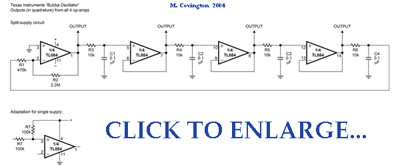 The "Bubba oscillator" appears in some Texas Instruments application
notes, including
this one.
The "Bubba oscillator" appears in some Texas Instruments application
notes, including
this one.
Curious as to why they'd name an oscillator Bubba (even in Texas), I breadboarded one tonight.
The version shown in the diagram is my own and oscillated at 160 Hz,
giving a very pure sine wave at the third output (pin 8) and distorted sine waves
at the other outputs.
This is a phase shift oscillator.
Bubba's great idea, apparently, was that since op-amps come 4 to a package, you aren't actually increasing
the parts count if you use four of them instead of just one.
Only the first one actually amplifies; the rest are unity-gain buffers.
The phase shift is supposedly 90 degrees per stage,
so I expected to get two nice sine waves in quadrature and make a
circular oscilloscope trace.
No such luck.
The phase shift is more than 90 degrees in the first stage and less in the other three.
Only the third stage outputs a really good sine wave.
The gain of the first stage is critical;
I ended up with 2.0 megohms and 470k, respectively, in the feedback network.
Too much gain, and there's distortion (though not much of it makes it to the third stage).
On reading further (in Op-Amps for Everyone, TI's expensive book published by Newnes)
I find that this is about right. The appeal of the Bubba Oscillator is that it gives you one
undistorted sine wave from a low-impedance output.
Next, I'm going to try removing one of the op-amps from the loop (making it a 3-stage loop) and
using it to buffer the best sine wave, wherever it may be.
This should work equally well and have fewer parts.
Call it "Son of Bubba" - unless I can think of a better name.
The reason I got into this was to see if my knowledge of op-amps was up-to-date.
It wasn't.
Since I last looked at them closely about 10 years ago, low-voltage, rail-to-rail input-output (RRIO)
op-amps have taken over.
Not only is the 741 obsolete, but even the "modern" TL071 and TL081 are long in the tooth.
By the way, it appears that the TL081 and TL071 are now the same chip.
Same price, same specifications, same internal circuit diagram.
In the early 1980s, the '81 had a higher noise level, but no more.
TI doesn't actually say they're the same chip, but there's no documented difference.

|
 |
2004
August
16
|
Trophies and plagues?
Things I find while cleaning up old stacks of pictures...
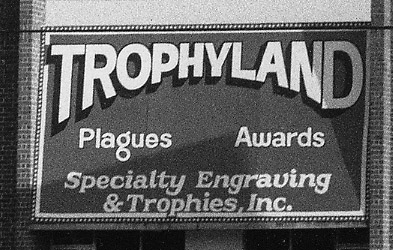
This is a copyrighted picture (see notice above). Copying it to other web sites is illegal.
About ten years ago, this was Atlanta's best-known misspelled sign,
at least in our household.
It was visible from I-85 near Jimmy Carter Boulevard.
Trophies and plagues. Do they also do pestilences?
Or maybe just plaques?

|
 |
2004
August
14-15
|
Deep metaphysical questions
I'm quoted extensively in
Jeff Duntemann's online diary
(August 14 entry; later to be archived
here)
on the subject of (religious) faith and reason.
My position is that if you think faith (trust) is contrary to reason, you've bought into
a mid-20th-century mistake - which I call "the theology of
Yes, Virginia, there is a Santa Claus"
(that marvelous exercise in doublethink that we all read in our youth).
See Jeff's column for more.
Jeff and I don't disagree as much has he indicates.
His definition of "reason" seems to be linked to material sense-perception in a way that mine isn't.
That is, his terminology (like most people's, in the 20th century) has a bit of a materialistic bias.
On a lesser, but still very deep, issue, as the new semester begins, see my essay,
What Should Grades Mean?
It's an attempt to justify, to my students, my approach to grading.
I've noticed that all too many college teachers, particularly in science and engineering, seem to
try to teach without doing the most fundamental thing, which is to
find out what's going on in the students' minds and make contact with it.
I see all kinds of mechanical grading procedures that seem to be designed to keep the
teacher from having any real contact with the student's intellect. Not in my classroom!
An example is grading computer programs by the output, without looking at the code.
My students are often startled that I actually read their programs and try to
reconstruct what they were thinking when they wrote them.
I suppose it's my North Campus background; I once taught English composition.

|
 |
2004
August
13
|
Detoothed
To my great relief, the tooth extraction went very easily.
The tooth came out while the dentist was rocking it to loosen it.
It turned out to be an underdeveloped tooth, without much root attachment,
and it would have fallen out anyhow in a few years.
(Could have saved my money...)
The other 3 wisdom teeth never developed at all.
What I had not realized is that the aftermath of a tooth extraction is not necessarily painful.
Maybe Victorian dentistry was onto something.
Deal with problems by pulling them out!
Speaking of Victorians, this evening I'm taking Melody and the girls to see
a performance of H.M.S. Pinafore,
Gilbert and Sullivan's 19th-century musical comedy
about a (real) bureaucrat who runs Queen Victoria's navy but has never been on a ship.
(The real name of the bureaucrat was William Henry Smith. He is the "son" in W. H. Smith & Son, the
chain of small bookstores - originally railway-station newsstands - that pervades England and Canada and
is now establishing itself in the United States.)
Melody, Cathy, and Sharon have been hearing me sing snippets of Pinafore since the early 1980s; at last
they'll see it actually performed.
It's the kind of comedy that depends on taking a wacky idea much too far,
in a dainty Victorian way; you laugh at it rather
than with it, and the comedy does not require any element of surprise.
That's why people enjoy the same Gilbert and Sullivan musicals over and over.
(And yes, I know that a pinafore is a kind of skirt. The word sounded nautical, so Gilbert and Sullivan
used it as the name of a ship.)

|
 |
2004
August
12
|
Wasp, idiot, and tooth
 Wasp of the day (click to enlarge):
This picture was recently captured by The University of Georgia's
Climate Lab Webcam.
Wasp of the day (click to enlarge):
This picture was recently captured by The University of Georgia's
Climate Lab Webcam.
Idiot of the day:
The phone rang at 8:50 this morning. It was a drunken-sounding man who announced that he was
"one of the 10 smartest people in the state" and then rambled on to say "you need to look for a job"
and eventually explained, "because of the way you treated Vince Dooley" (our recently
retired athletic director).
I don't know Coach Dooley.
It turned out that the drunken-sounding caller was under the impression he was
talking to the president of the University of Georgia.
Not me!
I have the caller's name and phone number, thanks to Caller ID, and have sternly
warned him not to call me any more.
This afternoon my one and only wisdom tooth, which came in 25 years ago,
is to be removed. It's a straightforward extraction; the problem is that it's forming
a pocket with the adjacent tooth. I hope it goes well.
In Victorian novels, people were "having a tooth drawn" almost at the drop of a hat,
without anesthesia... I'll at least have Novocain.

|
 |
2004
August
8
|
How I fixed a buzzing yoke
This is an electronics repair note and is intended only for people familiar
with the high-voltage precautions needed for repairing CRT computer monitors safely.
If you are not familiar with high-voltage precautions, please do not remove
the cover of a monitor. It contains 25,000 volts and can retain this charge for
days after being turned off.
Having said that...
One of Cathy's monitors (an old 14-inch that she had decorated with blue paint and flowers) started
making a buzzing noise.
At first I thought it was arcing, but careful examination (with ears rather than eyes) showed
that the sound was coming from the deflection yoke.
In one position (lying on its right side), the monitor did not buzz.
To fix it, I applied PVC pipe cement (a thin, clear glue sold by the can in plumbing sections of hardware stores)
generously all over the yoke, including the area between the yoke and the neck of the CRT.
I applied it from several angles, holding paper underneath to catch it, and must have used a couple of ounces.
For most but not all of the process, the monitor was in the non-buzzing position, lying on its side.
Because PVC cement is flammable, this can only be done safely
after the monitor has cooled down and lost most of
its high voltage, and then it needs several hours to dry.
But it worked! I suspect PVC pipe cement has other uses in electronics as an insulator and sealant.

|
 |
2004
August
5-7
|
Cartier-Bresson / Lassell's Triple Double
I'm still spending most of my time doing things other than writing blog entries...
Photographer Henri Cartier-Bresson has recently died at a ripe old age.
He may be the photographer who best represents the 20th century, a period in which
(in my opinion) photography was a finer art than painting or sculpture.
He was definitely - though indirectly - a strong influence on my own photography
(terrestrial, not astronomical).
You can see some of his pictures
here and
here.
It could be argued that serious photographers talk about Ansel Adams but actually
take pictures like Cartier-Bresson. He created a style of photography that is now
extremely familiar to all of us; we think of it as the normal way of using a camera,
but it need not have been, and in fact at one time definitely wasn't.
 Lassell's Triple Double is real and is quadruple.
Lassell's Triple Double is real and is quadruple.
I'm referring to a striking group of stars reported by
William Lassell
in Monthly Notices of the Royal Astronomical Society, Vol. 17, p. 66
(which was some time back in the 1870s; I read it but did not note the date).
I found it this evening with my 8-inch telescope.
It's located at R.A. 21:33:50, Dec. +32 16 (J2000.0), and consists of four wide
double stars arranged in a neat parallelogram, all symmetrically oriented.
The stars are mostly 10th magnitude and fit in a medium-power field.
The accompanying picture is not a photograph;
it's a chart generated with TheSky 6.

|
 |
2004
August
2-4
|
A farewell and some congratulations
I've been too busy to write blog entries; other writing has included
a $2,000,000 grant proposal. We'll see how it turns out...
On Monday, Melody and I (and most of the Linguistics Program) attended
the funeral of Bill Provost, who had directed
the program until just a few weeks ago.
He had been suffering chronic liver and kidney problems for a long time,
but we didn't know it.
All we knew was that he was mild-mannered, well-liked, and genuinely
concerned about everyone around him.
He was a specialist in Old and Middle English.
And gladly wolde he lerne, and gladly teche.
Congratulations to Jeff and Carol Duntemann, who have just celebrated the 35th anniversary of their meeting.
As a happily married couple, they are an inspiration to us all,
but especially to Melody and me (we're the same kind of couple).
More here (July 31 entry)
or here depending
on whether you catch Jeff's blog before or after the files get archived.
 And congratulations to my graduate student
Lorina Naci,
who has just finished her master's degree
and landed a scholarship to Cambridge.
And congratulations to my graduate student
Lorina Naci,
who has just finished her master's degree
and landed a scholarship to Cambridge.
She has been a most valued member of my research team for the past year and a half,
and we're sad to lose her, but happy that she's going on to greater things!
Her master's thesis contains some important discoveries,
but it can't be published yet because of nondisclosure agreements with the funding source, so I can't
actually tell you what Lorina has accomplished. But it's exciting.
[University of Georgia photo.]

|
 |
2004
August
1
|
Controlling Num Lock when nobody is logged on
(and why you might want to)
On my desktop PCs, I prefer to use a compact keyboard on which the numeric keypad shares keys with the
alphabet, like a laptop keyboard.
What I actually use is the keyboard of the IBM PS/2 Model 25, a quaint 1988 computer that never sold
very well but had a great keyboard; I bought a lot of the keyboards on the surplus market a few years ago.
Unfortunately this keyboard doesn't have a light to tell you whether Num Lock is on or off.
And Num Lock controls whether U, I, O, J, K, and L are letters or digits.
Well... My computer started requiring me to hit Num Lock (actually Shift-NumLock)
before typing my password.
I'm glad I figured this out, or I might never have logged on!
It turns out that the computer sets the state of Num Lock three times:
- The BIOS sets it when you boot up. There is a BIOS setting for whether you want it on or off.
- Windows sets it before any user logs on. This is a registry setting.
- Windows sets it again when a particular user has logged on.
In my case, only the second of these was incorrect. For some reason it had gotten set to
"Num Lock on when nobody is logged on" rather than the opposite, and it was obscuring my password.
The cure was to set the Registry setting
HKEY_USERS\.Default\Control Panel\Keyboard\InitialKeyboardIndicators = 0
(instead of 2, which means Num Lock on).
There's a similar setting under HKEY_CURRENT_USER for your account after you've logged on.
But you won't need to set it in the registry.
Just set Num Lock on or off as you prefer, and log off; your choice will be saved.

|
 |
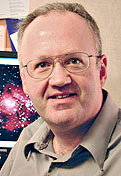

![]()




 Another trip to Fry's, this time with Sharon in tow,
for the second day of the one-day sale
(all I know is what I read in the papers!).
We came back with several gadgets, including a 175-watt inverter ($18, with 100% rebate)
for charging the laptops in the car.
Another trip to Fry's, this time with Sharon in tow,
for the second day of the one-day sale
(all I know is what I read in the papers!).
We came back with several gadgets, including a 175-watt inverter ($18, with 100% rebate)
for charging the laptops in the car.
 This evening Melody and I went to
This evening Melody and I went to  The electronic test equipment comprises many staple items and also some
The electronic test equipment comprises many staple items and also some


 Welcome to Computer Science 4540.
This is where it meets!
Welcome to Computer Science 4540.
This is where it meets!




 Lassell's Triple Double is real and is quadruple.
Lassell's Triple Double is real and is quadruple.
 And congratulations to my graduate student
And congratulations to my graduate student